 Published in 2020 by The Rosen Publishing Group, Inc. 29 East 21st Street, New York, NY 10010 Copyright 2020 by The Rosen Publishing Group, Inc. All rights reserved. No part of this book may be reproduced in any form without permission in writing from the publisher, except by a reviewer. First Edition Editor: Liz Krajnik Book Design: Reann Nye Photo Credits: Series art (frame) HiSunnySky/. Library of Congress Cataloging-in-Publication Data Names: Emminizer, Theresa, author.
Published in 2020 by The Rosen Publishing Group, Inc. 29 East 21st Street, New York, NY 10010 Copyright 2020 by The Rosen Publishing Group, Inc. All rights reserved. No part of this book may be reproduced in any form without permission in writing from the publisher, except by a reviewer. First Edition Editor: Liz Krajnik Book Design: Reann Nye Photo Credits: Series art (frame) HiSunnySky/. Library of Congress Cataloging-in-Publication Data Names: Emminizer, Theresa, author.
Title: Saltwater crocodile: the largest reptile / Theresa Emminizer. Description: New York: PowerKids Press, [2020] | Series: Animal record breakers | Includes index. | Summary: At the waters edge, a deadly saltwater crocodile lies in wait, its body tensed to lunge after its prey. It grips its catch with lethal, 5-inch-long (12.7 cm) teeth and powerful jaws, exerting the strongest bite force of any animal on Earth! More than 23 feet (7 m) long and a whopping 2,200 pounds (998 kg), saltwater crocodiles are the largest reptiles on the planet. In this book, readers will get an eye-opening look at the saltwater crocodile and learn about the reptiles habitat, behavior, diet, life cycle, and irreplaceable ecological importance--Provided by publisher. | Crocodiles--Juvenile literature. | Crocodiles--Juvenile literature.
Classification: LCC QL666.C925 E46 2020 | DDC 597.98/2--dc23 LC record available at https://lccn.loc.gov/2019027562 Manufactured in the United States of America CPSIA Compliance Information: Batch #CWPK20. For Further Information contact Rosen Publishing, New York, New York at 1-800-237-9932. CONTENTS WILD REPTILES Reptiles are cold-blooded animals with thin, dry pieces of skin called scales. Measuring upward of 23 feet (7 m) long and weighing 2,200 pounds (998 kg), saltwater crocodiles are the biggest reptiles in the world! Saltwater crocodiles look a bit like dinosaurs. They have wide, heavy bodies, short, strong legs, and big heads. 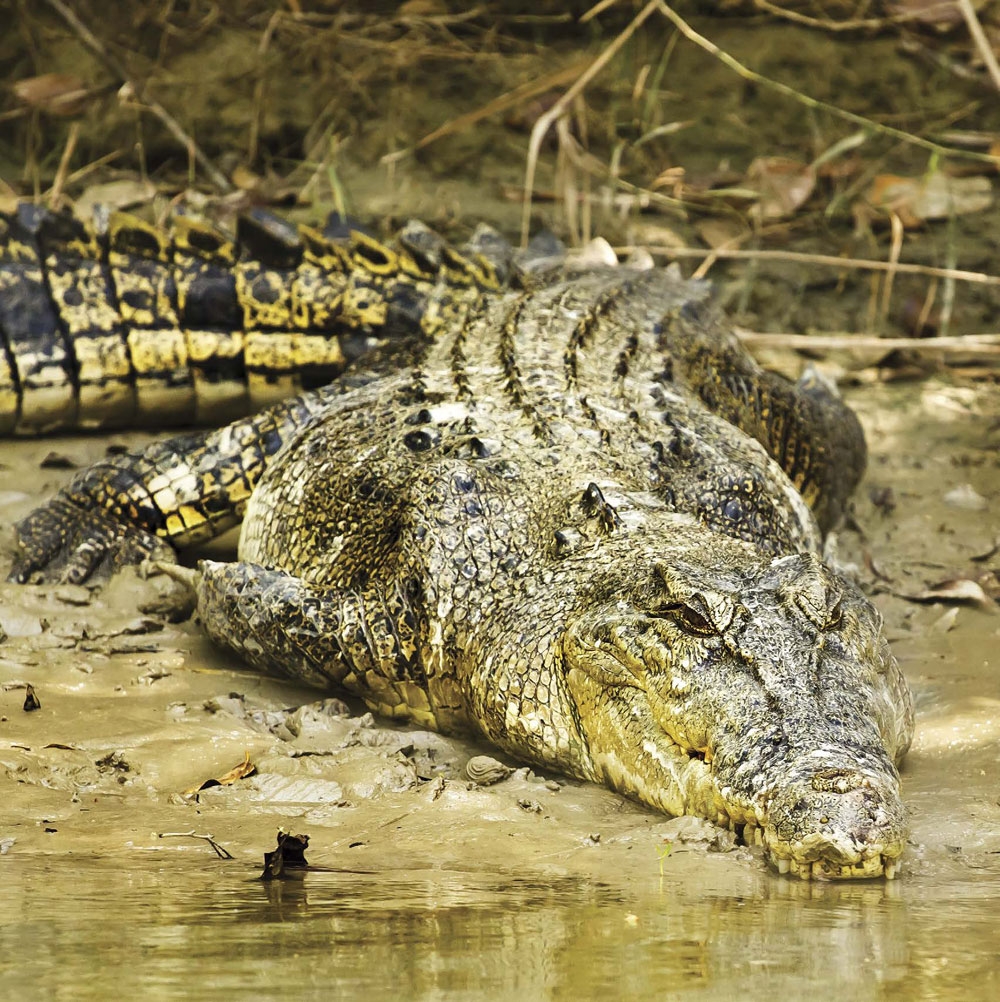 Saltwater crocodiles are nicknamed salties.
Saltwater crocodiles are nicknamed salties.  Saltwater crocodiles are nicknamed salties.
Saltwater crocodiles are nicknamed salties.
COOL CROCODILIANS Saltwater crocodiles are also called estuarine crocodiles. They got their scientific name Crocodylus porosusfrom Johann Schneider. Scientists sort animals into different groups. The largest of these groups is called an order. Saltwater crocodiles are part of the crocodilian order. There are 23 living species, or kinds, of crocodilians on Earth.
The crocodilian order can be divided into three smaller groups called families. The crocodilian families are alligatoridae, crocodylidae, and gavialidae. Saltwater crocodiles are part of the crocodylidae family. There are 15 species, or kinds, of crocodylidae. 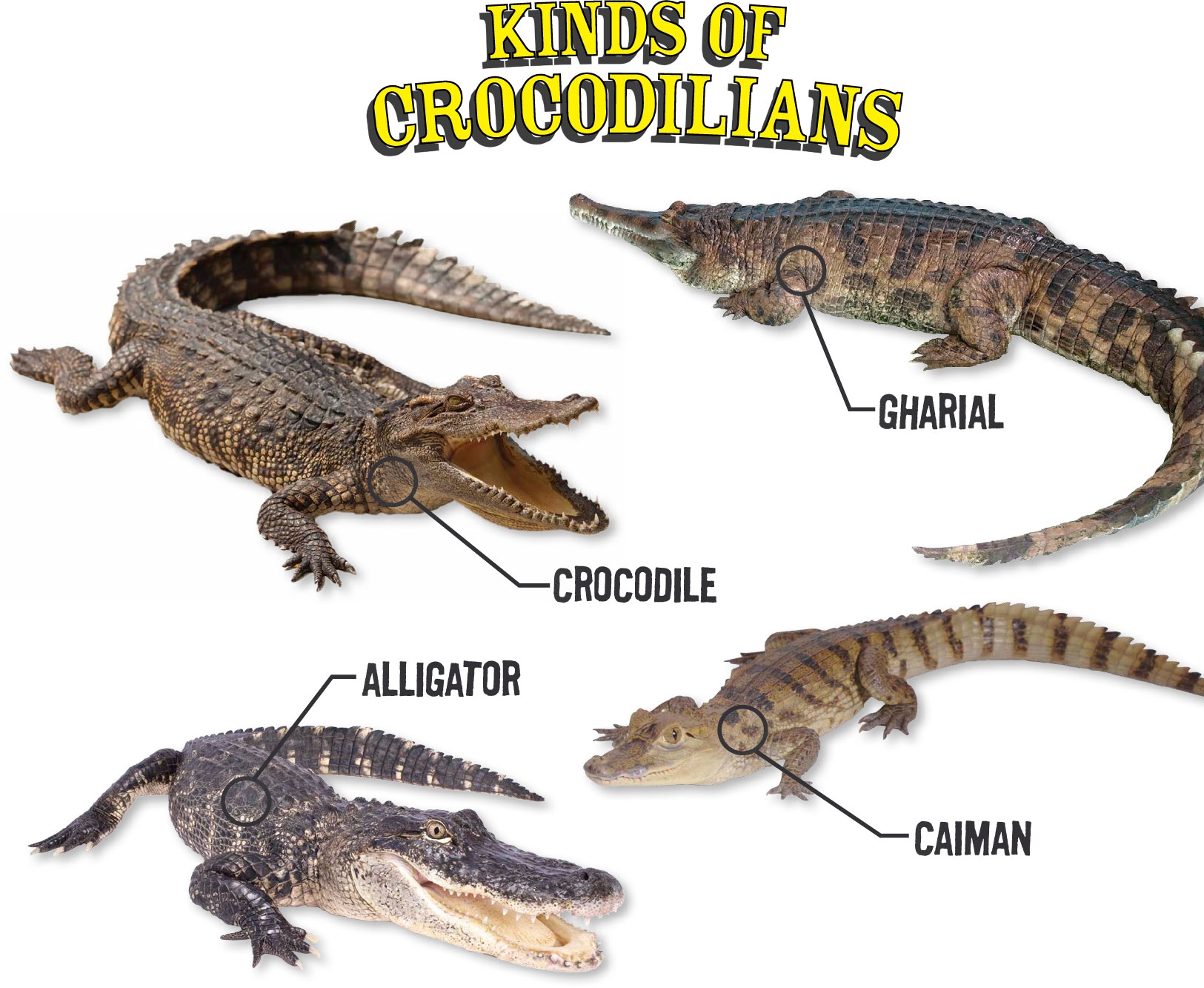 Saltwater crocodiles are the largest crocodilians, and Cuviers dwarf caiman are the smallest. WHERE THE CROCODILES CREEP Saltwater crocodiles can be found in Australia, India, and Southeast Asia in both saltwater and freshwater .
Saltwater crocodiles are the largest crocodilians, and Cuviers dwarf caiman are the smallest. WHERE THE CROCODILES CREEP Saltwater crocodiles can be found in Australia, India, and Southeast Asia in both saltwater and freshwater .
They live in swamps, marshes, rivers, and coastal waters. They can even live in the open ocean for days or sometimes weeks. Crocodiles are very strong swimmers. Although they move slowly on land, they can reach speeds of up to 18 miles (29 km) per hour in water. They themselves forward using their long, powerful tails. They also have special see-through eyelids that help them see underwater.
ANIMAL ACTION While swimming, saltwater crocodiles hold their arms and legs close to their bodies. This helps them move faster. 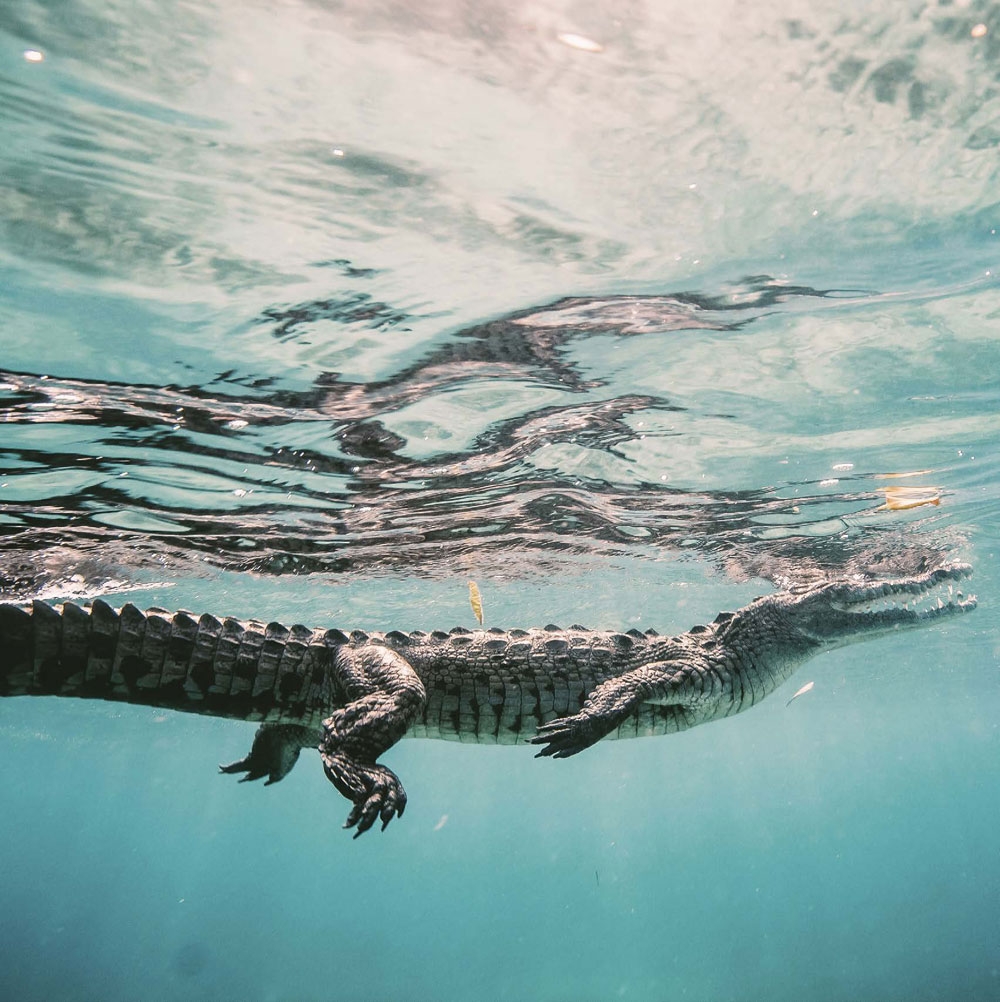 Saltwater crocodiles swim three times faster than the fastest human swimmers! AWESOME ADAPTATIONS An adaptation is a change in a living thing that helps it live better in its habitat. Saltwater crocodiles have many special adaptations. Their webbed feet and long, flat tails are specially made to help them swim. Their eyes and nostrils are placed high on the top of their heads, rather than low on the sides.
Saltwater crocodiles swim three times faster than the fastest human swimmers! AWESOME ADAPTATIONS An adaptation is a change in a living thing that helps it live better in its habitat. Saltwater crocodiles have many special adaptations. Their webbed feet and long, flat tails are specially made to help them swim. Their eyes and nostrils are placed high on the top of their heads, rather than low on the sides.
This allows them to stay hidden when they hunt, with their bodies submerged, or underneath the water, while their eyes and nose peek out. 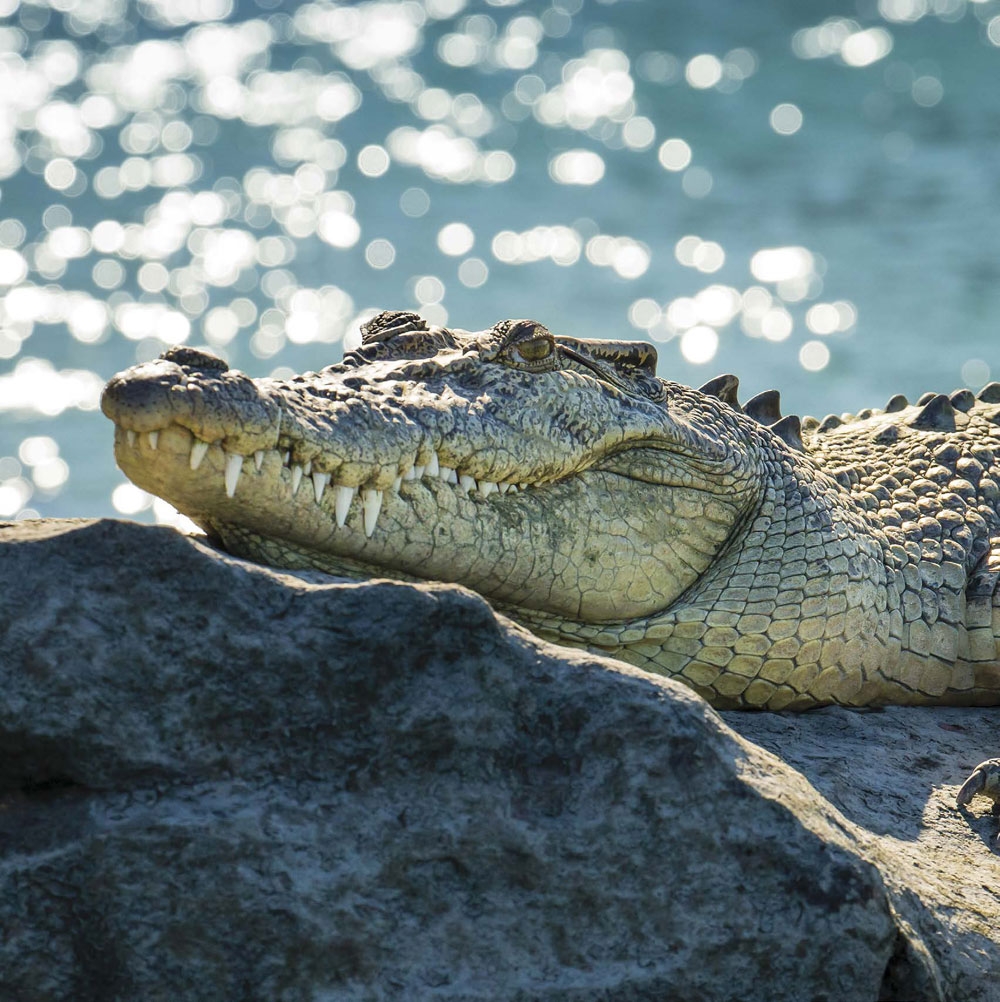 When they arent swimming, crocodiles like to warm up in the sun. A DEADLY DIET Saltwater crocodiles are carnivores, or meat-eaters. They have the strongest bite force of any animal on Earth. They catch their prey with deadly, 5 inch (12.7 cm) long teeth and powerful jaws. Saltwater crocodiles hunt by ambush, or sneak attack.
When they arent swimming, crocodiles like to warm up in the sun. A DEADLY DIET Saltwater crocodiles are carnivores, or meat-eaters. They have the strongest bite force of any animal on Earth. They catch their prey with deadly, 5 inch (12.7 cm) long teeth and powerful jaws. Saltwater crocodiles hunt by ambush, or sneak attack.
They are opportunistic hunters, which means theyll eat whatever they can catch. This includes small animals, such as fish, birds, and turtles, and much larger animals, such as wild boar and water buffalo. People need to watch out for saltwater crocodiles, too. ANIMAL ACTION Saltwater crocodiles have been known to attack people who get too close. Most attacks occur in or near water. 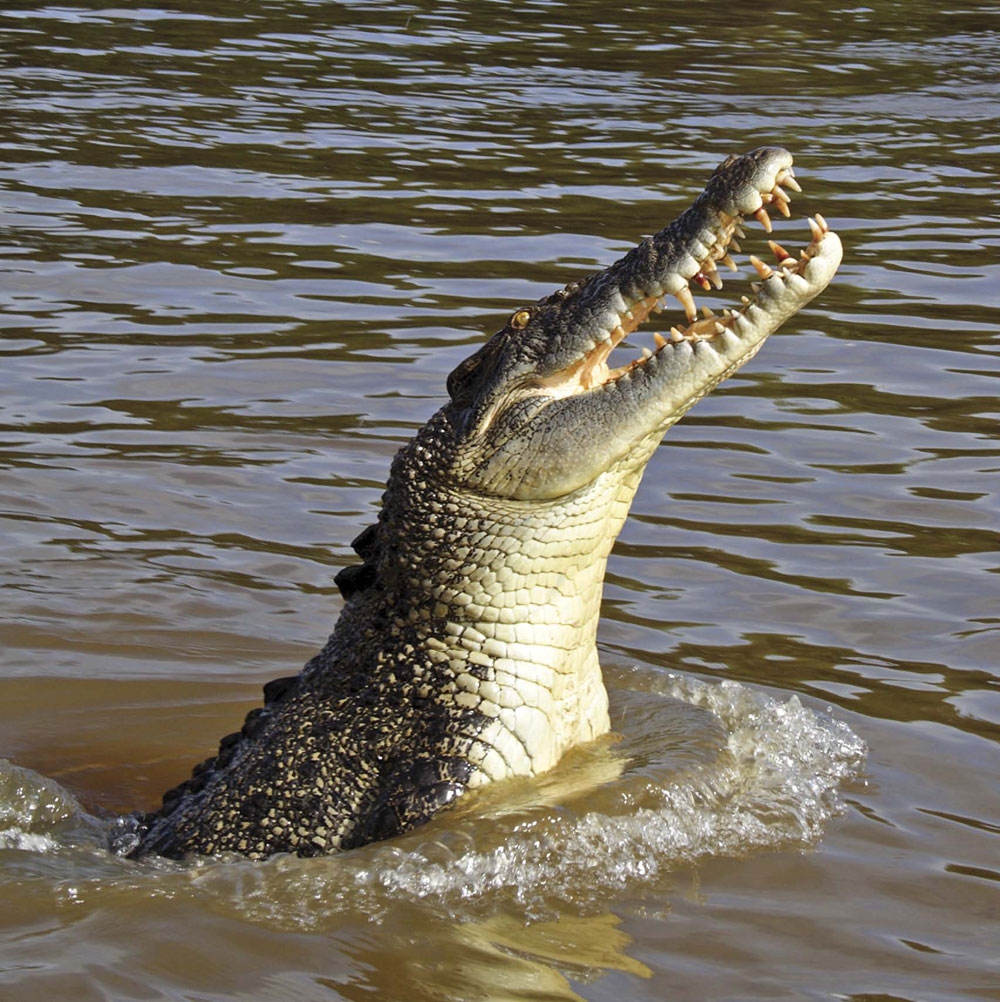 Saltwater crocodiles have 64 to 68 teeth.
Saltwater crocodiles have 64 to 68 teeth.
FROM EGG TO ADULT Saltwater crocodiles begin their lives as eggs. Females can lay as many as 90 eggs, but usually lay between 40 and 60. Eggs are kept safe in nests made of mud and plants close to water. Mother crocodiles bury their nests and their eggs from predators. The eggs . When a mother can hear her babies chirping, she digs them out and carries them to the water where they quickly learn to swim.
ANIMAL ACTION Whether a crocodile baby is male or female is based on the nests temperature, or how warm or cold it is. Warmer temperatures produce males, and cooler temperatures produce females. 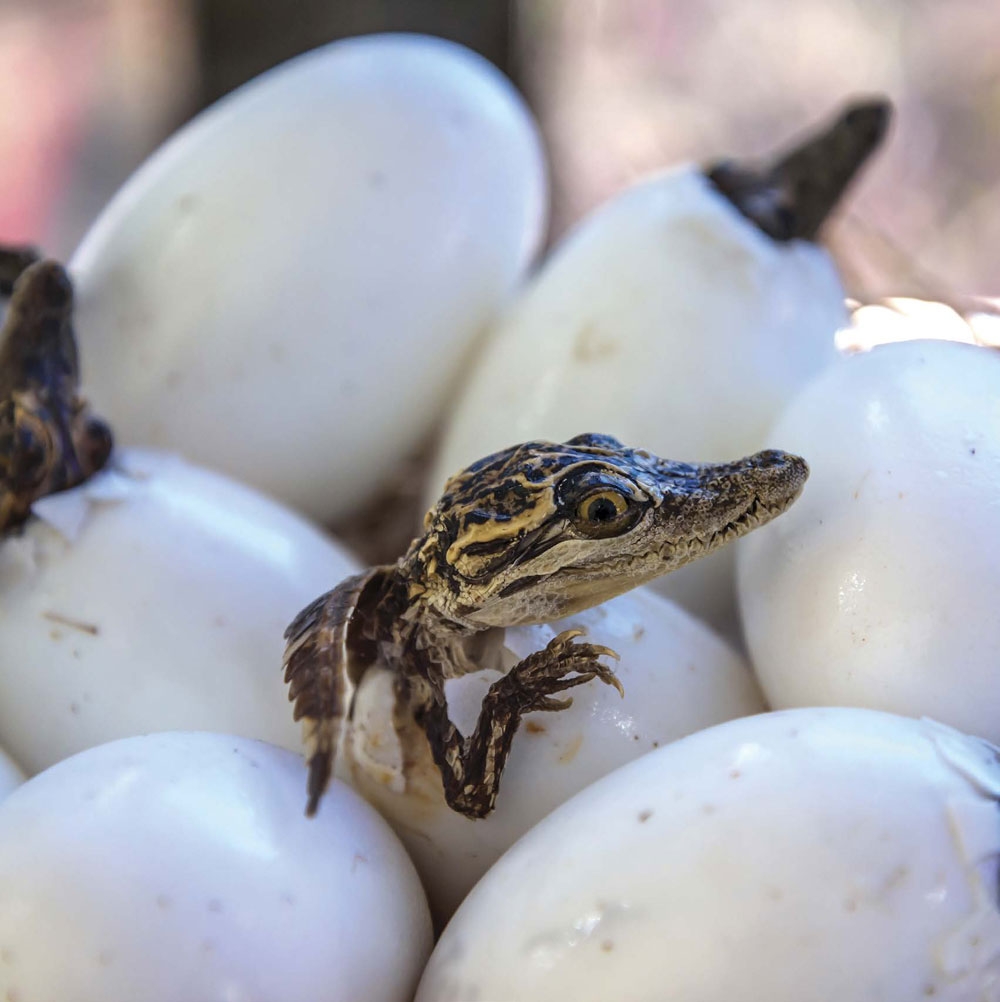 Baby crocodiles are called hatchlings. STRIPES AND SPOTS For the first few months after they hatch, mother crocodiles look after their young. Young crocodiles are yellow with black stripes and spots. As they grow older their color changes and darkens.
Baby crocodiles are called hatchlings. STRIPES AND SPOTS For the first few months after they hatch, mother crocodiles look after their young. Young crocodiles are yellow with black stripes and spots. As they grow older their color changes and darkens.
Adult crocodiles are grey with lighter tan areas. Female crocodiles reach adulthood at around 10 to 12 years old and males at around 16 years old. By that time, they are able to find and have babies of their own. Saltwater crocodiles can live to be between 65 and 100 years old. 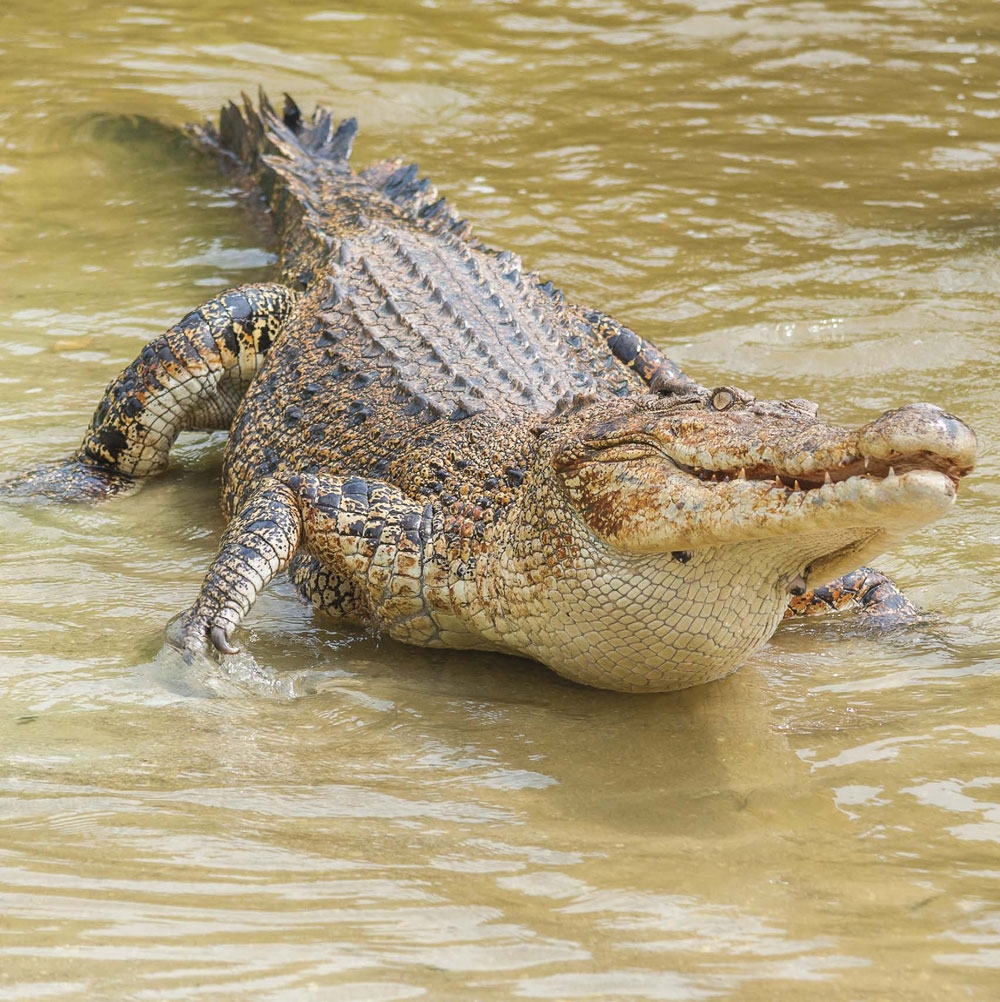 Adult saltwater crocodiles have stripes and spots on their sides and tails, but not on their bellies. CROCODILE BEHAVIOR Saltwater crocodiles are thought of as very intelligent animals.
Adult saltwater crocodiles have stripes and spots on their sides and tails, but not on their bellies. CROCODILE BEHAVIOR Saltwater crocodiles are thought of as very intelligent animals.
They are able to with each other using different noises. They may bark, hiss, growl, or chirp. Baby crocodiles chirp to let their mothers know that theyve hatched. Young crocodiles may bark if they are upset or in danger. Adults may make low growling sounds when communicating with mates. Saltwater crocodiles are very .
Adult males sometimes hiss at other crocodiles to tell them they arent welcome in their area. 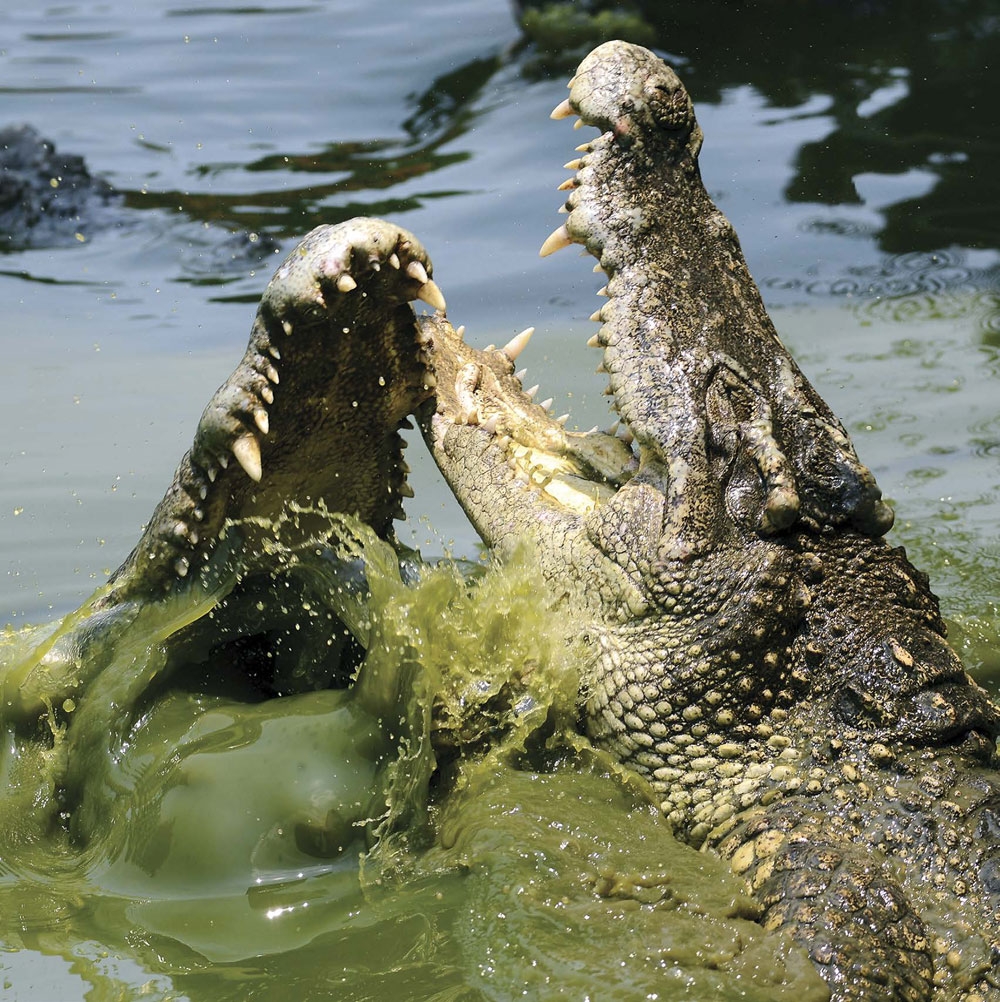
Next page
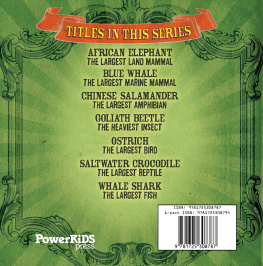
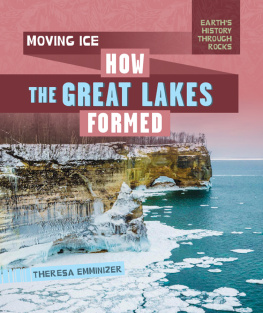
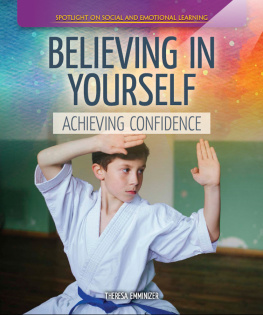

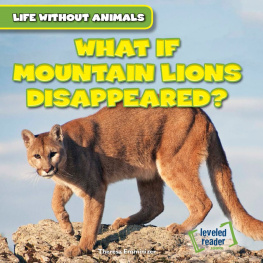
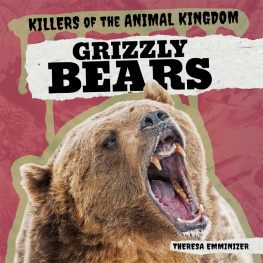

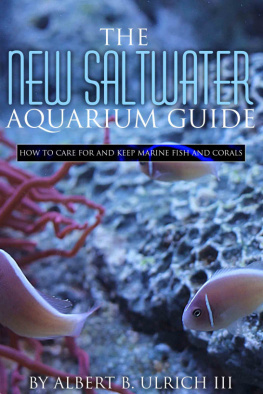
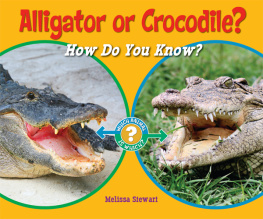
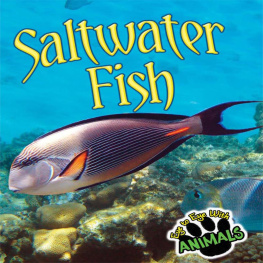
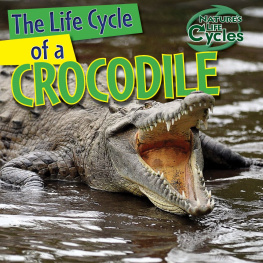

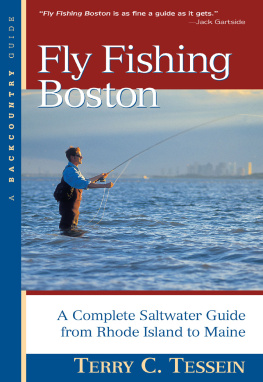
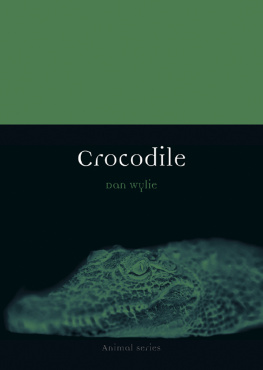

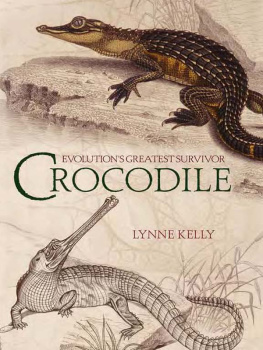
 Published in 2020 by The Rosen Publishing Group, Inc. 29 East 21st Street, New York, NY 10010 Copyright 2020 by The Rosen Publishing Group, Inc. All rights reserved. No part of this book may be reproduced in any form without permission in writing from the publisher, except by a reviewer. First Edition Editor: Liz Krajnik Book Design: Reann Nye Photo Credits: Series art (frame) HiSunnySky/. Library of Congress Cataloging-in-Publication Data Names: Emminizer, Theresa, author.
Published in 2020 by The Rosen Publishing Group, Inc. 29 East 21st Street, New York, NY 10010 Copyright 2020 by The Rosen Publishing Group, Inc. All rights reserved. No part of this book may be reproduced in any form without permission in writing from the publisher, except by a reviewer. First Edition Editor: Liz Krajnik Book Design: Reann Nye Photo Credits: Series art (frame) HiSunnySky/. Library of Congress Cataloging-in-Publication Data Names: Emminizer, Theresa, author. Saltwater crocodiles are nicknamed salties.
Saltwater crocodiles are nicknamed salties.  Saltwater crocodiles are the largest crocodilians, and Cuviers dwarf caiman are the smallest. WHERE THE CROCODILES CREEP Saltwater crocodiles can be found in Australia, India, and Southeast Asia in both saltwater and freshwater .
Saltwater crocodiles are the largest crocodilians, and Cuviers dwarf caiman are the smallest. WHERE THE CROCODILES CREEP Saltwater crocodiles can be found in Australia, India, and Southeast Asia in both saltwater and freshwater . Saltwater crocodiles swim three times faster than the fastest human swimmers! AWESOME ADAPTATIONS An adaptation is a change in a living thing that helps it live better in its habitat. Saltwater crocodiles have many special adaptations. Their webbed feet and long, flat tails are specially made to help them swim. Their eyes and nostrils are placed high on the top of their heads, rather than low on the sides.
Saltwater crocodiles swim three times faster than the fastest human swimmers! AWESOME ADAPTATIONS An adaptation is a change in a living thing that helps it live better in its habitat. Saltwater crocodiles have many special adaptations. Their webbed feet and long, flat tails are specially made to help them swim. Their eyes and nostrils are placed high on the top of their heads, rather than low on the sides. When they arent swimming, crocodiles like to warm up in the sun. A DEADLY DIET Saltwater crocodiles are carnivores, or meat-eaters. They have the strongest bite force of any animal on Earth. They catch their prey with deadly, 5 inch (12.7 cm) long teeth and powerful jaws. Saltwater crocodiles hunt by ambush, or sneak attack.
When they arent swimming, crocodiles like to warm up in the sun. A DEADLY DIET Saltwater crocodiles are carnivores, or meat-eaters. They have the strongest bite force of any animal on Earth. They catch their prey with deadly, 5 inch (12.7 cm) long teeth and powerful jaws. Saltwater crocodiles hunt by ambush, or sneak attack. Saltwater crocodiles have 64 to 68 teeth.
Saltwater crocodiles have 64 to 68 teeth. Baby crocodiles are called hatchlings. STRIPES AND SPOTS For the first few months after they hatch, mother crocodiles look after their young. Young crocodiles are yellow with black stripes and spots. As they grow older their color changes and darkens.
Baby crocodiles are called hatchlings. STRIPES AND SPOTS For the first few months after they hatch, mother crocodiles look after their young. Young crocodiles are yellow with black stripes and spots. As they grow older their color changes and darkens. Adult saltwater crocodiles have stripes and spots on their sides and tails, but not on their bellies. CROCODILE BEHAVIOR Saltwater crocodiles are thought of as very intelligent animals.
Adult saltwater crocodiles have stripes and spots on their sides and tails, but not on their bellies. CROCODILE BEHAVIOR Saltwater crocodiles are thought of as very intelligent animals.